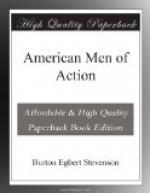What the defenses of the channel were, no one knew. It was reported to be full of torpedoes. But perhaps Dewey remembered Farragut at Mobile Bay. At any rate, he did not hesitate, but kept straight on, and the fleet had almost passed the harbor mouth, before its presence was discovered. Then the shore batteries opened, but without effect, and the entire squadron passed safely into the harbor. Then followed long hours of waiting for the dawn, and at five o’clock came the signal, “Prepare for action,” for the Spanish fleet had been sighted at anchor far down the harbor.
Fifteen minutes later, the Spaniards opened fire, but Dewey went silently on toward his goal. Suddenly, a short distance away, there was a dull explosion, and a great mass of water and mud sprang into the air. A mine had been exploded; the fleet had entered the mine fields. Now, if ever, it would be blown into eternity, but there was no pause in the progress of that silent line of battle. From the bridge of the Olympia, the most exposed position in the squadron, Dewey watched the progress of his ships. In the conning tower, eagerly awaiting the word to fire, was Captain Gridley. At last, with a final glance at the shore, Dewey bent over the rail.
“You may fire when ready, Gridley,” he said, quietly.
Ready! Surely that was satire on Dewey’s part, for just one second later the bridge under his feet leaped like a springboard as the great gun beneath it gave the signal. Scarcely had the shell left the muzzle when an answering roar came from the other ships. The battle had begun, the Spanish ships were riddled with a shower of bursting shells, their crews cut to pieces, and the ships themselves set on fire. The guns of the American squadron roared with clocklike regularity, while the firing from the Spanish ships steadily decreased. Two hours of this work, and the smoke hung so heavy over the water that it was difficult to distinguish the enemy’s ships.
“What time is it, Rees?” asked Dewey, of his executive officer.
“Seven forty-five, sir.”
“Breakfast time,” said Dewey, with a queer smile. “Run up the signals, ‘Cease firing,’ and ‘Follow me.’”
Again it was a lesson from Farragut, and Dewey, steaming back down the harbor, signalled “Let the men go to breakfast.” His captains, coming aboard the Olympia, gave a series of reports unique in naval history. Not a man had been killed, not a gun disabled, not a ship seriously injured. Three hours were devoted to cooling off and cleaning the guns, getting up more ammunition, and breakfast was leisurely eaten.
Meanwhile, across the bay, on the riddled and sinking Spanish ships the wildest confusion reigned. At eleven o’clock, the American fleet was seen again approaching, and a few minutes later, that terrible storm of fire recommenced. There was practically no reply. Three of the Spanish ships were on fire, and their magazines exploded one after another with a mighty roar; a broadside from the Baltimore sank a fourth; a shell from the Raleigh exploded the magazine of a fifth, and so, one by one, the Spanish ships were blown to pieces, until not one remained. An hour later, the shore batteries had been silenced, and Dewey hoisted the signal, “Cease firing.”




